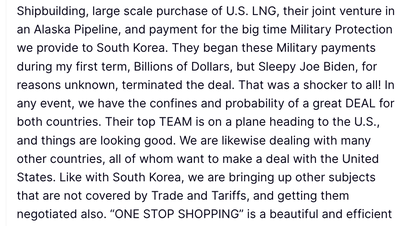The US economy will maintain steady growth in the third quarter as inflation eases, wages rise, boosting consumer spending ahead of a tense US election.
The US economy likely maintained steady growth in the third quarter as falling inflation and strong wage growth boosted consumer spending ahead of a tense US presidential election revolving around political issues with financial implications for people and businesses.
The Commerce Department's initial estimate of third-quarter gross domestic product (GDP) will be released less than a week before Americans go to the polls on November 5 to choose between Democratic Vice President Kamala Harris and former President Donald Trump. Polls show the race is tight.
 |
| People shop at Eastern Market in Washington, DC, U.S., August 9, 2024. Reuters/Umit Bektas/File Photo |
Americans, who saw the economy as one of the top election issues, were frustrated by high food and housing costs, even as the economy defied recession forecasts and continued to outperform global peers.
Voter surveys have consistently shown Trump holding an advantage when asked who would be better at managing the economy, including the latest Reuters/IPSOS poll released on Tuesday.
However, the economy remains resilient despite the Federal Reserve raising interest rates by 5.25 percentage points in 2022 and 2023 to curb inflation.
“ It looks like the US economy is going to have a strong finish to the year ahead of the election ,” said Christopher Rupkey, chief economist at FWDBONDS. “ There are some headwinds, but the economy is certainly in better shape than it was four years ago and shows no signs of slowing down.”
GDP likely grew at an annualized rate of 3.0% in the July-September period, the same pace as in the April-June quarter, according to a Reuters poll of economists. Estimates ranged from 2.0% to 3.5%.
The survey was completed before data on Tuesday showed the goods trade deficit jumped to a 2-1/2-year high in September, prompting the Atlanta Federal Reserve to lower its estimate of GDP for the last quarter to 2.8%, from an initial forecast of 3.3%.
That would still be well above the 1.8% rate that Fed officials consider inflation-free. The report would add to annual revisions released last month that showed the economy was much stronger than previously estimated.
 |
| Customers shop at stores at Oculus and Westfield during Black Friday shopping in New York City, U.S., November 24, 2023. Reuters/Brendan McDermid/File Photo |
The revisions have nearly eliminated the gap between GDP and gross domestic income (GDI), an alternative measure of growth, as of the second quarter. Before the revisions, some economists said the gap suggested economic activity might have been overstated.
With inflation nearing the Fed’s 2% target, the US central bank is now easing policy, starting that cycle last month with an unusually large half-percentage-point interest rate cut. The reduction in borrowing costs, the first since 2020, brought the Fed’s policy rate down to a range of 4.75% to 5%.
Some economists see the economy’s resilience as a sign that monetary policy may not be as tight as many think. They also say the economy’s continued strength comes in part from rising productivity, which is helping absorb higher labor costs.
Support factors for low-income households
Although the labor market has slowed, layoffs remain near record lows and wages continue to rise steadily. Household net worth has increased thanks to the booming stock market and higher home prices. Savings remain high and inflation has fallen significantly, providing support to households, especially low-income families.
The personal consumption expenditures (PCE) price index, which excludes the volatile food and energy components — a closely watched measure by the Fed — is forecast to have increased at a 2.1% rate in the third quarter, down sharply from 2.8% in the second quarter.
“ As we enter a disinflationary cycle, wages have been rising, so you’re seeing real wage growth,” said Brian Bethune, an economics professor at Boston University . That’s certainly one factor keeping the economy going. The other two factors are home prices, which have been stagnant, and the stock market.
Consumer spending, which accounts for more than two-thirds of economic activity, is estimated by some economists to have grown at least 3.5%, up from 2.8% in the second quarter. However, there are concerns that much of this growth is being driven by middle- and upper-income households, who have more flexibility and alternatives in their consumption.
Business spending, particularly on aircraft, is also expected to contribute to GDP growth. Companies are likely to have increased investment in technology, primarily artificial intelligence. Government spending is also expected to contribute to growth.
However, inventories are likely to moderate, while real estate investment, which includes home construction and home sales, likely fell for a second straight quarter. Trade may have been a drag on GDP for three straight quarters.
Hurricanes Helene and Milton, as well as the Boeing strike, likely had a minimal impact on GDP growth in the last quarter, although the impact could be larger in the October-December quarter.
Some economists believe the resilience of the economy could prompt the Fed to adopt a more gradual policy easing path than it expected last month.
“ If the economy proves resilient and we see only some mild signs of softening in the labor market, rather than a significant deterioration, the Fed will not need to cut rates as much as it predicted in its summary of economic projections. We will have a gradual path of rate cuts that will lead to a higher end point for the Fed funds rate than the Fed has anticipated,” said Conrad DeQuadros, senior economic advisor at Brean Capital.
Source: https://congthuong.vn/kinh-te-hoa-ky-duoc-du-bao-toa-sang-truoc-them-bau-cu-my-356569.html


![[Photo] Prime Minister Pham Minh Chinh chairs meeting on science and technology development](https://vphoto.vietnam.vn/thumb/1200x675/vietnam/resource/IMAGE/2025/5/17/ae80dd74c384439789b12013c738a045)


![[Photo] Readers line up to visit the photo exhibition and receive a special publication commemorating the 135th birthday of President Ho Chi Minh at Nhan Dan Newspaper](https://vphoto.vietnam.vn/thumb/1200x675/vietnam/resource/IMAGE/2025/5/17/85b3197fc6bd43e6a9ee4db15101005b)

![[Photo] More than 17,000 candidates participate in the 2025 SPT Competency Assessment Test of Hanoi National University of Education](https://vphoto.vietnam.vn/thumb/1200x675/vietnam/resource/IMAGE/2025/5/17/e538d9a1636c407cbb211b314e6303fd)


























![[Photo] Nearly 3,000 students moved by stories about soldiers](https://vphoto.vietnam.vn/thumb/1200x675/vietnam/resource/IMAGE/2025/5/17/21da57c8241e42438b423eaa37215e0e)






































































Comment (0)